Point-of-purchase (POP) is becoming a crucial cog in contemporary marketing strategies
By Marika Gabriel
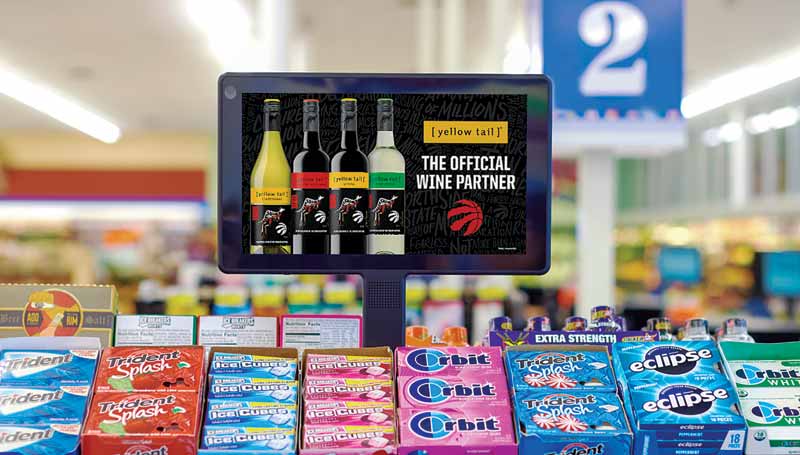
Point-of-purchase (POP) displays engage shoppers in a contextually relevant space, complemented by creative in-store offers for added impact. Photos courtesy Vistar Media
Point-of-purchase (POP) advertising displays and materials capitalize on location. Strategically positioned where daily purchasing decisions are made—often near checkout counters or within retail spaces—their primary objective is to sway consumer behaviour by capturing attention, highlighting product benefits, and triggering impulse purchases. As POP evolves with the integration of digital technologies, it transforms retail dynamics by engaging consumers precisely at critical decision-making moments.
To understand Canada’s journey in this space, Sign Media Canada (SMC) spoke with Vistar Media’s Lorena Forster, senior account executive based in Toronto, and Olivier Paquet-Thibodeau, senior account executive based in Montreal, Que. Their insights illuminate the pivotal role of POP displays in contemporary marketing strategies and shed light on emerging opportunities in this burgeoning segment.
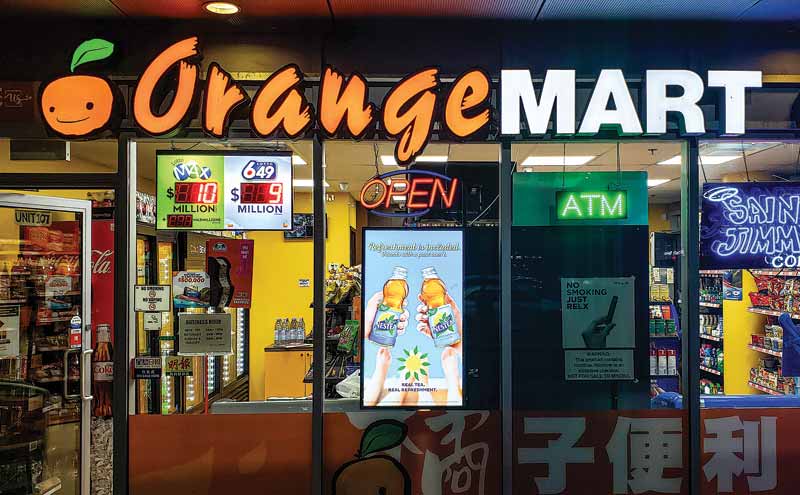
Focusing on brand lift studies, a typical assessment can examine customers exposed to the ad, exploring their awareness, consideration, and intent.
Sign Media Canada (SMC): How integral are POP displays in your marketing strategies?
Lorena Forster (LF): With POP, there’s a huge opportunity in Canada. We’ve seen major growth in the U.S. first, and now we’re starting to see this in Canada as well, from both a supply and demand standpoint. From a supply standpoint, we’re starting to see more screens being added to convenience stores, gas stations, and grocery stores. From a demand standpoint, we’re seeing advertisers excited about this. They are now able to reach customers in the out-of-home (OOH) space in a high-intent environment. Being close to this high-intent point-of-purchase (POP) is really exciting.
SMC: What specific goals do you aim to achieve through these channels?
Olivier Paquet-Thibodeau (OP-T): With these kinds of locations, sales become the most important key performance indicator (KPI). You are exactly at the moment where you can influence the buyer. It is up-and-coming in Canada. We are not yet where the U.S. is, but I’m pretty sure if the supply—and I mean the media owner—were to build this inventory, the advertiser would come into the space. Among all the media channels, it is one of the fastest growing demands. So, yes, it is very focused on sales in terms of KPI at the moment, because we can promote your sales, your product, and influence the customer at the moment where they need to pick between brand A and brand B. So, if you are there, it’s a great way to influence that journey.
SMC: What current trends in POP displays are proving most effective for engaging consumers? Do you have any examples from Canada?
LF: In Canada, we’re always a couple of years behind the U.S. in terms of growth and scale. However, when it comes to looking at verticals such as consumer-packaged goods (CPG) and retail, these are two verticals that naturally make sense for the space. You’re in a contextually relevant environment as a shopper. So, it’s a natural fit where advertisers are most likely to jump on quickly.
We’re also seeing advertisers get more excited and creative in the finance or auto space. For example, Capital One ran a creative for convenience stores, for credit cards, that was a play on the convenience store consumer already in-store (see images on page 32). By playing on words in the convenience store or talking about candy to a customer who is about to buy candy/bubble gum, we’re witnessing creativity that may not seem like a natural fit in the same way.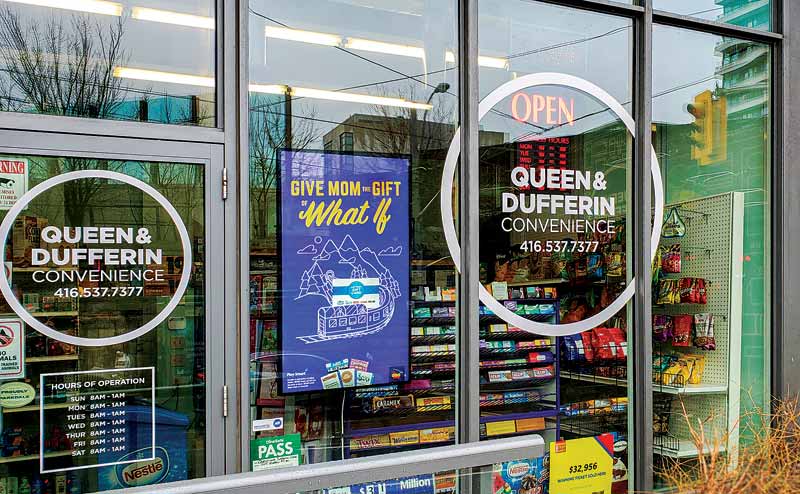
SMC: What are the key challenges in deploying effective POP displays?
OP-T: For now, in Canada, it’s just a matter of inventory. The location of the screen is not always something you have control over.
LF: A lot of times in OOH, we’re running campaigns across a variety of venue types—convenience stores and gas stations—but we’re also running billboards for the advertiser. For example, for the Capital One creative, the campaign is going to be very different for a billboard and versus the convenience store. Like with any creative or medium, considering the creative for a contextually relevant environment will help drive better results.
OP-T: Often, what we see is advertisers have a video creative they plan to use on YouTube and other social media. Then we share the creative specs: it’s a 15-second video, and they say, “Great, we have one.” But POP displays involve a different engagement environment. So, having a location-specific creative would be ideal. This is not something we see most of the time and is a key challenge, because when you’re waiting in line or shopping for your product, it needs a different kind of messaging. It’s not just brand messaging saying, “Do you know our candy?” It’s more like, “Pick our candy because it’s better,” to put it simply.

From a supply standpoint, more screens are being added to convenience stores, gas stations, and grocery stores in Canada.
LF: Exactly. In convenience stores, I believe, 96 per cent of purchases are impulse. Therefore, when you look at the candy example, this makes sense!
SMC: What innovative technologies are being leveraged to effectively use POP displays?
OP-T: We use global positioning system (GPS) data to understand audiences. We examine data points aligning with GPS data. Our goal is to understand consumer behaviour, locate where they are, where they are likely to be, and target them with ads. We analyze our target audience, both their online and offline behaviour, and their movement patterns. If needed, we activate OOH strategies in POP locations based on their behaviours. Whether they are travelling, driving, or shopping at the grocery store, we activate these strategies based on their movement patterns. This is the primary technology we leverage.
LF: Jumping on the creative aspect, if we want to take it a step further, dynamic creative in POP is important. So, leveraging data and changing your creative in real time—whether it’s a promotional offer or a countdown to an upcoming promo—is important. Already being contextually relevant in a shoppers’ space is great, and then, having that immediate creative offer in-store takes it a step further.
OP-T: For example, it can be weather. I’m thinking of weather because, right now, here in Montreal, it is a 43 C. So, it’s an opportunity to say, “Hey, you need to stay hydrated with a Gatorade” or another cold beverage. That’s a technology that can be leveraged. When done so—even though they are technically more expensive—we see a higher engagement.
SMC: How does the effectiveness of static POP advertising compare with digital POP solutions in today’s retail landscape?
LF: At Vistar Media, we only handle digital OOH (DOOH) at the moment. We will be planning both static and digital in the future. That said, in terms of the mediums, there’s always going to be a place for static and digital in advertising, whether in POP, billboards, or any other OOH venue type. Traditional OOH allows for more generic always-on messaging, while digital allows you to be more creative, whether it’s data points, something seasonal, like the weather, being able to change creatives based on last-minute decisions, or promotions. So, there is flexibility there. There’s a place for both; it just depends on your strategy.
OP-T: Yes, the buying process is also quite different. If we focus on OOH advertising, whether it’s an ad panel or digital screen, it’s considered more media focused. However, if it’s simply a sticker placed next to your product, this is negotiated at the store level with the local representative of the product. For instance, if you want to sell Molson, you will approach Loblaws and request to place your product prominently on their top shelf, perhaps with a promotional giveaway. This buying process is fairly different. It typically doesn’t involve a media agency or vendor like ours; instead, it’s managed at the local level.
SMC: What are the dos and don’ts in a typical POP display? How do you distinguish between what works and what doesn’t?
OP-T: Starting with the dos, if your KPI is increasing sales, using promotions can help achieve this goal. Whether it aligns with your brand’s best interests is another important consideration.
LF: POP is different than a large-format ad. So, having contextually relevant messaging will take you a long way, along with being clear about your strategy, audience, and creative message.
OP-T: Importantly, this is both, a do and a don’t. Don’t put too many words on your ad. Do keep it simple.
LF: I also believe all venue types have value. It just depends on the vertical, the message, and your objectives. For instance, a glossy auto ad for the launch of a Nissan might not resonate as well in a convenience store compared to a playful confectionery ad or something like the Capital One example. When you’re in a convenience store and you see an ad directly connecting a convenience store with a credit card, that’s when the venue type works well.
OP-T: It’s more about mindset. We often think in terms of advertising Coca-Cola or candies in convenience stores. However, it’s also people who frequently swipe cards, meaning they are credit card owners. It’s a more creative approach, focusing on mindset. The same principle applies if you’re targeting pharmacies or liquor stores. In liquor stores, for example, it’s not just about promoting liquor; you might advertise something like—and I’m speaking for the audiences in Montreal—Osheaga. It’s more about mindset in a specific location than product in a specific location.
SMC: What metrics are you using to measure the impact of POP as part of OOH advertising campaigns?
OP-T: Impressions are the first, and still very important. We can measure foot traffic studies, although it’s more challenging. Also, when you’re selling on the spot, you don’t want to divert people to another store. Brand lift studies are, so far, the most applicable metric where you aim to understand brand perception, awareness, consideration, and possibly creative recall.
LF: Yes, it primarily involves brand lift studies. We assess customers who were exposed to the ad to understand their awareness, consideration, and intent. If they use various venue types in OOH such as billboards and POP displays, we measure and provide results on how each venue type performed. After running a campaign, we provide these results for advertisers to evaluate. They can then decide whether the campaign performed well and should be used again in the future, or if adjustments are needed in the creative messaging to improve results.
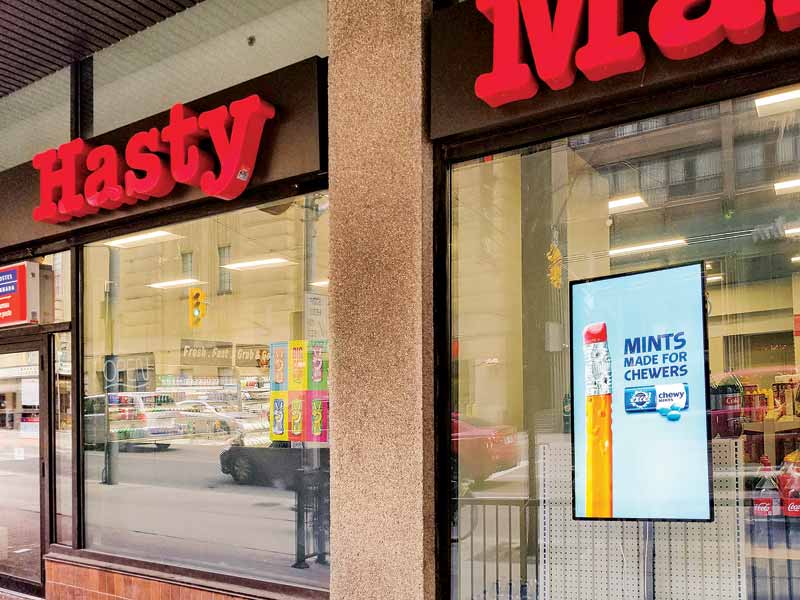
From a demand standpoint, advertisers are excited about being able to reach customers in the out-of-home (OOH) space in a high-intent environment.
OP-T: We can also measure the drop-off from awareness to intent. For instance, while awareness of a product like Coca-Cola might be universally high, the intent to purchase could be low for various reasons. This metric is important to consider, as it may lead to adjustments in strategies or product offerings. Advertisers often focus on this KPI to understand how effective a campaign is.
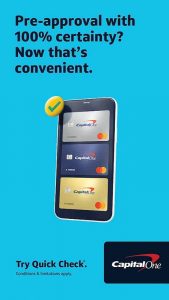
The Capital One creative underscores the importance of the mindset in a specific location rather than the product in a specific location.
SMC: What does the future of POP look like?
LF: Everybody is talking about retail media. We’re seeing it primarily in the digital space, and we’re already witnessing a large number of screens in grocery stores across the U.S. I believe we will see a lot more of that in Canada in the coming years.
OP-T: Exactly, it’s convenient for everyone because TVs are fairly cheap today. With software, you can put out your own promotions and advertisements. Everybody wins. And I always feel like a screen—because we’re so accustomed to our screens—is more appealing than some kind of print. So, I think we will see POP advertising in most stores. The demand isn’t quite there right now because the supply isn’t either; but once there is supply, the demand will increase rapidly. I believe it will be the fastest-growing part of DOOH. This is because some individuals might not want to see billboards running screens 24/7, even causing light pollution. However, in locations such as convenience stores, or big box outlets, or any establishment with operating hours, integrating DOOH advertising indoors seems much more feasible and acceptable.





